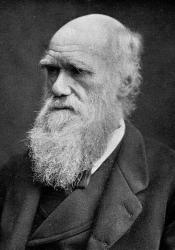Social Darwinism
On November 24, 1859, Charles Darwin published his controversial book “On the Origin of Species.” This book detailed his scientific discoveries on the theory of evolution. It postulates that creatures evolve over generations through the process of natural selection. Darwin wrote the book in a generalized form which attracted a widespread audience. His ideas invited scientific, religious, and philosophical discussion.
One major claim from the work is that species come from a common descent, including humans. The idea of humans as creatures subject to evolution combined with the idea of natural selection led to what came to be called social Darwinism which was an idea developed by Herbert Spencer to extend the ideas of Darwin into the economic and ethical spheres. Spencer wrote, "Society advances where its fittest members are allowed to assert their fitness with the least hindrance" (qtd. in Ali). What he is arguing for is a laissez faire economic system which is a “policy of minimum governmental interference in the economic affairs of individuals and society” (Encyclopedia Britannica).
Spencer coined the term survival of the fittest, which he derived from the idea of natural selection. Basically that the strong survive and the weak die. He extended this idea over society and argued that “the population of unfit people would slowly decline and would be died out because of their failure to compete” (Ali). These ideas were used to describe people as developmentally better or worse dependent upon classification of race, nationality, sex, class, etc. It supported ideas like eugenics and imperialism, which weren’t widely criticized until after the atrocities of two world wars in which they were taken to their extreme.
The effects of these ideas can be seen throughout the Victorian Era which is reflected in the literature, such as in the case of “The Woman in White” when Count Fosco is describing the way which he views how the world works, “When the criminal is a brutal, ignorant fool, the police in nine cases out of ten win. When the criminal is a resolute, educated, highly-intelligent man, the police in nine cases out of ten lose” (Collins ch. 3). Count Fosco is using intelligence as a way of justifying crime. If you are clever enough to get away with the crime then you are somehow above the law. The morality observed here is that the strong conqueror over the weak which is reflective of how survival of the fittest functions within society through the lens of social Darwinism.
The association with social Darwinism can also be seen in the character of Laura Fairlie, and specifically her comparison with Anne Catherick. In basically every instance the two characters are mirrors of each other except for one thing; their social standing. While Laura is seen as desirable and attractive, Anne is thrown into an asylum. Therefore, it must be concluded that the reason for Laura’s desirability is because of her status and nothing else. The men’s possession of her throughout the novel is reflective of possession of economic status, and they are in competition with each other over that economic status.
Works Cited
Ali, Sramad. “VIEW: Social Darwinism and American Laissez-Faire Capitalism.” Daily Times (Lahore, Pakistan), 9 Oct. 2013. EBSCOhost, discovery.ebsco.com/linkprocessor/plink?id=deee4e3f-c013-3bb0-bd87-31a5886ca484.
“Laissez-faire.” https://www.britannica.com/, 22 Sept. 2022, www.britannica.com/topic/laissez-faire.
Collins, Wilkie. The Woman in White. Project Gutenburg, 1996, www.gutenberg.org/ebooks/583.

